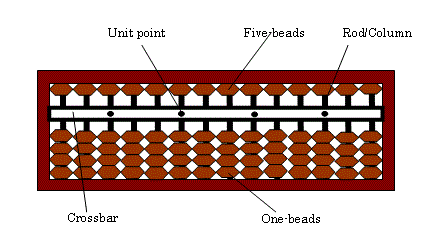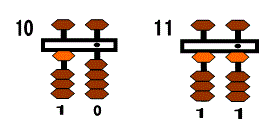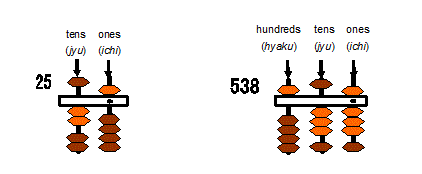Japanese sence of numbers and soroban
Since immemorial time, calculation has been a basic human activity.
Numbers are essential for performing any arithmetic calculations.
The Arabic numbers, such as 0123456789, are most often used these days.
It is unimaginable to do calculations without the display of numerals.
However soroban is one such system where calculations are performed without involving the display of Arabic numeral.
Famously called eAbacusf in English, it has its rudimentary origin in Mesopotamian civilization.
In the 16th century, it was introduced to Japan from China.
It went through several changes to what is now called eSorobanf or Japanese Abacus.
Since then, it became a traditional calculator in Japan.
Soroban doesnft use the Arabic numbers. The uniqueness of soroban is that it replaces numbers with beads.
This tool is capable of doing not only addition and subtraction but also multiplication and division as well as square root equations.
I think the way of representing numbers on soroban has a lot to do with Japanese language and has greatly affected Japanese sense of numbers.
Letfs look at the parts of the soroban.
The soroban is a rectangular wooden frame with lots of vertical rods fitted with beads (See the figure below).
The soroban is divided into two parts, the upper part and the lower part.
The bar dividing these two parts is called ecrossbarf.
In the upper part each rod has a single bead called gfive-beadh and the lower part of each rod holds 4 beads called gone-beadsh.
This means that each bead in the upper part stands for the numeral e5f and the lower beads stand for the numeral e1f.
Zero in the soroban is represented by pushing all the five-beads to the upper portion and all the one-beads to the lower portion of the frame (See the figure).

Letfs start representing numbers on the soroban.
To display numbers, you will have to choose one rod with a unit point and move one one-bead upwards. This represents 1.
You can represent 2 by sliding one more one-bead upwards. Now you can see that there are two one-beads in the upward position on the cross bar.
Moving more one-beads upward adds to the existing ones making it 3 and 4 depending on the number of one-beads you move up (see the figure below).
For representing 5 we use the five-bead instead of one-beads. In order to represent numeral 5, you just need to slide the five-bead downwards and move all the one-beads down (see the figure above). This equals 5.
Keeping the five-bead down, you push one one-bead up to represent 6. You can see that one five-bead and one one-bead pushed towards the crossbar represents 6 (5+1=6).
You can set 7, 8 and 9 by moving additional one-beadstowards the crossbar. (See the figure below)
@The numbers of soroban (0-9) are composed of one-beads and a five bead. This 1-5 number system plays an important role not only in soroban calculation but also in Japanese culture.

You can see that setting 9 uses up all the beads on the rod/column has and
we will not be able to add any more beads to it so we need to use the next rod/column on the left.
This second rod represents tens and hence it is called etens columnf.
In order to set 10, reset the eones columnf to zero position and move one one-bead up to the crossbar.
Now we have 10.
The soroban system uses something similar to the Arabic system while writing multi-digit numbers.
For example, for writing 10, we join 1 and 0 together so that the total value becomes ten.
Similar is the case in soroban where each rod/column has specific value.
To represent 11, we keep the 1 bead in the eten columnf and move the one bead up to the crossbar.

You can see the double e1sf next to each other as we write in the Arabic system.
It is now easy for you to represent 12, 13, and 14 and so on up to 19.
For making 20, we need to slide down the ones bead to zero and shift up two ones beads on the tens column. Hence, 20 consists of 2 in its tens digit column and zero in the ones digit column. It is easy to set 20 after resetting the soroban to zero as in this case you just need to lift up the two beads in the tens digit column.
Here are some pictorial examples for you to solve. Identify which figure represents what digit and see how much you could understand the soroban system.

@ 25@ A 47 B 50@C70@D81@E99.
We are now moving to represent three digit numbers from 100 to 999 using soroban. We need one more additional column called ehundreds columnf in order to represent three-digit numbers. Using this third column we can represent all the three digit numbers from 100 to 999. We can represent 100 by setting one on the hundreds column and setting the tens and ones columns to zero. This way, we can see the numbers from the left 1, 0 and 0 becoming 100. Two beads on hundreds column means 200, three beads means 300 and so on.
Now I will introduce how to read numbers in Japanese. There are two counting methods in the Japanese system. One is a Japanese original way of counting and the other is a Chinese way that come from China through gkanjih which are Chinese characters. Japanese people use the Chinese reading system to calculate. Counting from 1 to 10 goes gichih gnih gsanh gshih ggoh grokuh gshichih ghachih gkyuh and gjyuh. If you memorize those ten words you can easily say all the numbers up to 99 without the need to learn new words.
How to read Japanese numbers
| P | ichi |
| Q | ni |
| R | san |
| S | si/yon |
| T | go |
| U | roku |
| V | shichi/nana |
| W | hachi |
| X | kyu |
| PO | jyu |
| POO | hyaku |
| POOO | sen |
For example, 11 is said jyu-ichi in Japanese. The literal translation 11 is gten-oneh. 12 is jyu-ni in Japanese (gten-twoh), 13 is jyu-san and so on. Next comes 20. It is better to think of 20 as two tens. Two is ni and ten is jyu, so 20 is ni-jyu. Isnft that easy? 21 is two tens and one, so two is ni, ten is jyu, and one is ichi, so 21 is pronounced ni-jyu ichi. You only need to memorize two more words in order to learn more numbers in Japanese. They are ghyakuh for hundred, with which you can pronounce up to 999, and gsenh for thousand, with which you can pronounce up to 9999.
This system of counting is suitable for soroban. Letfs set 25 on the soroban. Here, you will find two one-beads on the tens column and one five-bead on the ones column. We can read this number by first reading the number of beads on the higher column, number of the column and then the number of beads on the second column. In this case, we can read two (ni) ten (jyu) and five (go) as ni jyu go. Similar is the case while reading 538. Hence, sorobanfs number system harmonizes well with the Japanese language.

It might be very natural for the people whose language has same system as Japanese, such as Chinese and some other Asian languages. However, it is not natural for other languages.
English is one such different language. I have witnessed some Japanese students asking why 11 is not ten one but eleven and 12 is not ten two but twelve while they learn to count in English for the first time. They need to understand that those are not combination words but special ones.
There are innumerable languages in the world and each language has its own way of counting. Let us take an example. German language also has specific words for up to 12 like English.
There is one more special point in German numbers. They read numbers in reverse order for numbers after 20. For example, 22 is read gzwei und zwanzig (two and twenty)h and 93 is read gdrei und neunzig (three and ninety)h. You may think that all numbers are read form smaller digit to bigger digit in German which is not the case. Let us look at the three digit numbers like 222. It is read gzwei hundert zwei und zwanzig (two hundred two and twenty)h where they start to read from big digit and only in the last two digit to read reverse direction i.e. one first and ten later.
It is also interesting to look at the French number system. It has similar features as that of any other European language but the counting system changes for numbers 70s, 80s and 90s. 70 is gsoixante-dixh in French, and this is the combination of gsoixanteh and gdixh. gSoixanteh and gdixh mean sixty and ten respectively. 80 is pronounced gquatre-vingtsh which means four times twenty because gquatreh and gvingth means four and twenty. 90 is pronounced gquatre-vingts-dixh which means four times twenty and ten.
There is a method of practicing soroban called gYomiagezan (listening calculation).h In Yomiagezan the teacher reads the numbers and student adds (or substracts) them using soroban (sometime addition and subtraction). I have an experience doing Yomiagezan with a German student. But it is difficult to do during the early stages of learning soroban. I had to move my finger to and from over the soroban because of the German number system. The student said that she doesnft think German number system is good for soroban.
There are two ways to represent numbers smaller than 1 for the positive numbers i.e. fractions and decimals. I think that European people prefer fraction to decimal. gHow do you represent fraction by soroban?h I am often asked that by the European students who have basic skills in soroban. My answer is gIt is impossible to show fraction by sorobanh
On the contrary the Asian students never questioned me about that. This fact tell us the big difference is lying to grasp the idea of smaller number than 1 in between Europe and Asia.
I think that Japanese people prefer decimal to fraction. It has something to do with the fact that Japanese numbers is exactly in decimal system. In Japanese, there are names to express numbers by 10 like, 1, 10(jyu), 100(hyaku), 1000(sen), 10000(man), 0.1(wari), 0.01(bu), 0.001(rinn), 0.0001(mou). A traditional Japanese unit of volume -Go, Sho, To, and Koku- is also by 10. Go is equal to 1/10 Sho, 1/100 To and 1/1000 Koku. These are to measure of rice which is necessary in Japanese life. And those units are sometimes carved on the bar of old sorobans. (Picture) Itfs the way to use common feature as the decimal notation and make it easy to read the number on soroban.

Fraction is a way of expressing number, totally different from Decimal notation. As for Fraction, it depends on the number of denominator to become 1.@Three 1/3 are needed to become 1, and eight 1/8 are needed to become 1. This kind of fraction doesnft agree with Japanese language, which is based in Decimal notation, but it does in European society.
English has specific words for numbers up to 12, not up to 10. Itfs because 12 is a special number from the perspective of fraction.
12 has many divisors. There will be no remainder when 12 is divided by 1, 2, 3 and 4. You canft do the same for the numbers smaller than 12 including 10. You can divide 10 by 2, but you canft by 3. You canft divide 10 by 4. The fact that you canft divide by 4 is fatal especially when we think about a circle. A clock is to 12, and one minute is 60 seconds. Angle is also to 360 degrees, not to 10 or 100. The number 60 can be divided by any number from 1 to 6. The number 360 can be divided by any number from 1 to 10 except for 7. Those numbers are very important from the perspective that they can be divided by many numbers.
Being able to be divided is certainly the perspective of fraction.
Itfs easy to tell that English language is greatly influenced by this perspective of fraction. In English, there are commonly-used expressions like ghalfh and gquarterh. Especially we often find them in the expression of the telling time.1:15 is expressed as quarter past one, and 12:45 is expressed as quarter to one. 45 minutes can be expressed as three-quarter of an hour. Three months can be called quarter. Besides 25-cent coin is called quarter too. Four quarters is equal to one dollar.
In this way, money itself clearly shows the difference of sense of number between Japan and the West (in this case, United States).
In order to make this point clearer we need to know the Japanese currency system. In Japan the smallest currency is one yen coin. Next comes five, ten, fifty, a hundred yen and five hundred yen coins. Here we can see that up to five hundred the 1 and 5 pattern is kept constant. Also, this pattern continues in the bills as well. Japan has four kinds of bills, one thousand, two thousand, five thousand and ten thousand bills. The bills also seem to follow 1-5 system with an exception of two thousand yen bill which was made in commemoration of the millennium in the year 2000 and hasnft circulated well.
For example, the vending machines donft accept this bill.
In the States, 20-dollar bill which is a counterpart of 2000-yen bill in Japan are commonly used just like 10-dollar bills, 5-dollar bills and 1-dollar bills. It seems 25-cent coins are also convenient for Americans. This difference comes from the way Japanese understand numbers, which is based on decimal notation, and Americans, which is based on fraction. The 1-5 currency system is unconsciously lying in the Japanese mind and they must have felt discomfort when they used the 2,000-yen bill. Yes, the 1-5 counting system is the system of soroban.
Japanese are said to be good at mental calculation. Itfs because the simplicity of the Japanese number notation helps to deal with calculation, has taken roots deeply in Japanese mind. The soroban has been used for more than 400 years in Japan. We could conclude that the Japanese number system is the most suitable one for working with the soroban and the soroban can be called a tool that expresses the Japanese culture of numbers.





